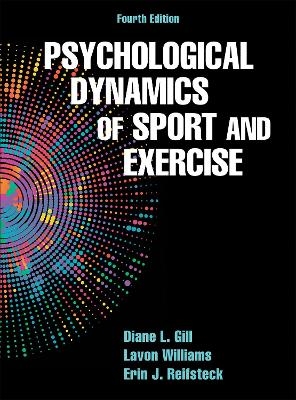
Psychological Dynamics of Sport and Exercise
Human Kinetics (Verlag)
978-1-4504-8466-4 (ISBN)
Authors Diane L. Gill, Lavon Williams, and Erin J. Reifsteck highlight key theoretical work and research to provide guidelines for using sport and exercise psychology in professional practice and personal physical activities.
The fourth edition of Psychological Dynamics of Sport and Exercise includes reorganized, revised content and relevant, up-to-date research to emphasize the areas of change and growth in the field in recent years. Specific updates to this edition include the following:
• Part IV on emotion is now expanded to include two in-depth chapters—one focusing on emotion and performance and one on physical activity and mental health—as well as a third chapter on stress management
• Part III on the popular topic of motivation is reorganized to emphasize contemporary research and connections to professional practice.
• The chapter on aggression and social development now includes more current research on prosocial and antisocial behavior as well as an expanded section on positive youth development.
• In-class and out-of-class lab activities replace case studies to provide scenario-based, experiential activities for a more applied learning experience.
• Updated end-of-chapter summaries, review questions, and recommended readings reinforce key concepts and encourage further study.
• Application Point sidebars have been updated to cover a wide variety of professions in order to connect the content with real-world application.
• A newly added image bank helps instructors prepare class lectures.
Content is organized into five parts representing major topics that are found in sport and exercise psychology curriculums. Part I provides an orientation, with chapters covering the scope, historical development, and current approaches to sport and exercise psychology. Part II focuses on the individual, with chapters on personality, attention and cognitive skills, and self-perceptions. Part III covers the broad topic of motivation, addressing the why question of physical activity behavior. Part IV looks at emotion, including the relationship between physical activity and emotion as well as stress management. Part V considers social processes in chapters on social influence, social development, and group dynamics, as well as cultural diversity.
With more in-depth coverage than introductory-level texts, Psychological Dynamics of Sport and Exercise, Fourth Edition, brings sport and exercise psychology to life for students as they prepare for their professional lives. Emphasis is placed on sport and exercise psychology concepts as they apply to three key areas of kinesiology professions: physical education teaching, coaching, and consulting; exercise instruction and fitness leadership; and sports medicine, rehabilitation, and athletic training. By focusing on these professional settings, readers will understand how psychology concepts are integral to real-world situations outside of the classroom.
Diane L. Gill, PhD, is a professor in the department of kinesiology at the University of North Carolina at Greensboro (UNCG). She held faculty positions at the University of Waterloo and the University of Iowa before moving to UNCG. At UNCG, she has served as associate dean of the School of Health and Human Performance and head of the department of kinesiology; from 2010 to 2015 she was the Linda Arnold Carlisle Distinguished Excellence Professor of Women’s and Gender Studies. She has more than 40 years of experience as a faculty member in kinesiology and specifically in sport and exercise psychology. Dr. Gill has been engaged in research and scholarly activity in sport and exercise psychology throughout her career. She has more than 100 scholarly publications on sport and exercise psychology topics and has given many presentations at major national and international conferences. She serves on several editorial boards and is the former editor in chief of Journal of Sport and Exercise Psychology. She is a fellow of several professional organizations, including the American Psychological Association (APA), the American College of Sports Medicine, and the National Academy of Kinesiology. She is a former president of the North American Society for the Psychology of Sport and Physical Activity (NASPSPA) and of Division 47 (Exercise and Sport Psychology) of the APA. In 2014, Dr. Gill received the NASPSPA Distinguished Scholar award; in 2015, she received the Distinguished Scientific and Research Contributions to Exercise and Sport Psychology award from APA Division 47. She received both her MS and PhD degrees from the University of Illinois and her undergraduate degree from the State University of New York at Cortland. Lavon Williams, PhD, is a professor of exercise and sport science at Guilford College, where she is currently the department chair. She previously held faculty positions at Western Illinois University, Northern Illinois University, and Purdue University. Involved in sport and exercise psychology research throughout her career, Dr. Williams has written more than 20 scholarly publications and has given more than 30 national and international presentations. She has served as the sport psychology academy chair of the National Association for Sport and Physical Education (NASPE) and as secretary of the SHAPE America Research Consortium. Dr. Williams is a past member of the executive board and the former research and practice division head for the Association for Applied Sport Psychology (AASP). She is currently a member of the American Kinesiology Association’s Publications Committee. Dr. Williams is an associate editor for Women in Sport and Physical Activity Journal (WSPAJ). She has served on the editorial board for Research Quarterly for Exercise and Sport, The Sport Psychologist, and WSPAJ and as an associate editor for Research Quarterly for Exercise and Sport (RQES) and the AASP Newsletter. She received her MS from the University of Oregon, her PhD from the University of North Carolina at Greensboro, and her bachelor’s degree from Texas Christian University. Erin J. Reifsteck, PhD, is an assistant professor in the department of kinesiology at the University of North Carolina at Greensboro (UNCG). In 2015 through 2016, Dr. Reifsteck served as principal investigator for two NCAA-funded studies to develop and evaluate the Moving On! program, which is based on a theoretical framework that integrates sport and exercise psychology principles. She received the Association for Applied Sport Psychology (AASP) Young Researcher Award in 2015 and was named an American Kinesiology Association Writing Scholar in 2014. Dr. Reifsteck’s current research focuses on promoting lifetime physical activity and health through the translation of psychosocial theory into practice. Her scholarly interests also include gender issues in sport, and she currently serves on the editorial board for Women in Sport and Physical Activity Journal (WSPAJ). She is a member of the North American Society for the Psychology of Sport and Physical Activity (NASPSPA) and AASP, where she also serves on the AASP research development committee. Dr. Reifsteck received her PhD and MS in kinesiology (sport and exercise psychology concentration) with a doctoral minor in educational research methodology from UNCG. She also received a graduate certificate in women’s and gender studies from UNCG and a health coach certificate through UNCG’s Department of Public Health Education. She earned her BS in psychology with a minor in neuroscience from Saint Francis University (Pennsylvania), where she played field hockey and was a two-time Academic All-American and Northeast Conference Scholar Athlete of the Year.
Part I. Overview of Sport and Exercise Psychology
Chapter 1. Introduction to Sport and Exercise Psychology
Kinesiology: A Multidisciplinary, Applied Field
Sport and Exercise Psychology as a Subdiscipline
Complexity of Sport and Exercise Behavior
Putting It Into Practice
Chapter 2. History of Sport and Exercise Psychology
Early Roots: 1890 to 1920
Early Sport Psychology Labs: 1920 to 1940
Isolated Sport and Exercise Psychology Studies: 1940 to 1965
Emergence of Sport and Exercise Psychology as a Subdiscipline: 1965 to 1975
Development of the Subdiscipline: 1975 to 1999
Sport and Exercise Psychology Today: 2000 to Present
Putting It Into Practice
Chapter 3. Understanding and Using Sport and Exercise Psychology
Paradigms and Sources of Knowledge
Research Into Practice
Using Sport and Exercise Psychology
Putting It Into Practice
Part II. The Person in Sport and Exercise Psychology
Chapter 4. Personality
Personality Defined
Early Theories and Current Biological Perspectives
Psychology Models of Personality
Personality Measures
Personality Research in Sport and Exercise Psychology
Relevant Personality Characteristics and Sport-Specific Psychological Skills
Putting It Into Practice
Chapter 5. Attention and Cognitive Skills
Attention Models and Perspectives
Research on Attentional Processes
Attention and Expertise
Attentional Control Strategies
Imagery
Putting It Into Practice
Chapter 6. Self-Perceptions
Self-Perceptions
Self-Schema and Identity
Multidimensional Self-Perceptions
Focusing on Physical Self-Concept
Self-Confidence and Self-Efficacy
Putting It Into Practice
Part III. Motivation
Chapter 7. Behavioral Approaches
Goals and Goal Setting
Behavioral Basics
Implementing a Behavior Plan
Behavioral Approaches in Professional Practice
Self-Regulation and Habits
Putting It Into Practice
Chapter 8. Cognitive Approaches to Motivation
Participation Motivation
Sport and Exercise Commitment
Sources of Sport Enjoyment
Self-Determination Theory
Putting It Into Practice
Chapter 9. Achievement Motivation
Attributions and Physical Activity
Atkinson’s Theory of Achievement Motivation
Achievement Goal Theory
Motivational Climate
Putting It Into Practice
Chapter 10. Integrated Approaches to Physical Activity Behavior
Physical Activity for Health and Well-Being
Theories and Models of Physical Activity Behavior
Integrated Approaches to Physical Activity Promotion
Physical Activity and Health Coaching
Excessive Participation: Exercise Dependence
Putting It Into Practice
Part IV. Emotions, Stress, and Coping
Chapter 11. Emotions and Performance
Emotion Concepts and Definitions
Positive and Negative Emotions—Accent on Positive
Emotion Models
Emotions and Performance
Anxiety Performance Models and Research
Multidimensional Anxiety Performance Models
Anxiety Patterns and Performance
Putting It Into Practice
Chapter 12. Physical Activity, Emotion, and Mental Health
Physical Activity and Emotion
Physical Activity and Mental Health
Physical Activity and Cognition
Physical Activity and Quality of Life
Putting It Into Practice
Chapter 13. Stress and Stress Management
Importance of Stress Management
Stress Models in Sport and Exercise Psychology
Stress Management Techniques
Putting It Into Practice
Part V. Social Processes
Chapter 14. Social Influence
Social Facilitation
Social Reinforcement and Performance
Social Cognitive Theory
Models: The Self and Socializing Agents
Social Support
Sport and Exercise Psychology Research on Social Support
Social Support and Physical Activity
Social Support in Injury Risk and Response
Putting It Into Practice
Chapter 15. Aggression and Social Development
Defining Aggression
Theories of Aggression
Aggression and Sport
Moral Behavior in Sport and Physical Activity
Positive Social Development Through Physical Activity
Putting It Into Practice
Chapter 16. Group Dynamics
Group Dynamics Concepts and Models
Group Performance
Leadership in Sport and Physical Activity
Cohesion in Sport and Exercise Groups
Applying Group Dynamics Through Team Building
Putting It Into Practice
Chapter 17. Culture and Cultural Competence
Culture: Basics and a Guiding Framework
Cultural Context of Sport and Exercise
Gender Scholarship in Sport and Exercise Psychology
Social Perspectives and Gender Stereotypes
Sexuality and Sexual Prejudice
Race, Ethnicity, and Social Class
Physicality and Weight Bias
Intersections and Cultural Relationships Revisited
Cultural Competence
Putting It Into Practice
| Erscheinungsdatum | 19.08.2017 |
|---|---|
| Verlagsort | Champaign, IL |
| Sprache | englisch |
| Maße | 216 x 279 mm |
| Gewicht | 1247 g |
| Themenwelt | Sachbuch/Ratgeber ► Sport |
| Weitere Fachgebiete ► Sportwissenschaft | |
| ISBN-10 | 1-4504-8466-2 / 1450484662 |
| ISBN-13 | 978-1-4504-8466-4 / 9781450484664 |
| Zustand | Neuware |
| Haben Sie eine Frage zum Produkt? |
aus dem Bereich


